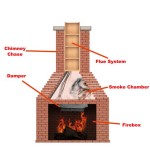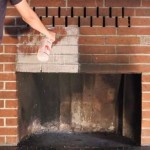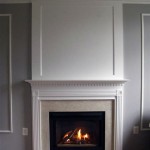Understanding Fireplace Mortar Mix: Composition, Application, and Maintenance
Fireplace mortar mix is a specialized type of mortar specifically formulated for the high-heat environment of a fireplace. Unlike general-purpose mortar, which can crumble and fail under extreme temperatures, fireplace mortar mix is designed to withstand repeated heating and cooling cycles without significant degradation. This article explores the components, application techniques, and maintenance procedures associated with fireplace mortar mix, providing a comprehensive understanding of its role in fireplace construction and repair.
Key Components of Fireplace Mortar Mix
Fireplace mortar mix typically consists of a blend of specific materials chosen for their heat resistance and bonding properties. The precise composition of a particular mix can vary depending on the manufacturer and intended application, but common ingredients often include:
Portland Cement: Portland cement serves as the primary binder in most fireplace mortar mixes. It provides the initial strength and sets the mortar upon hydration. However, standard Portland cement alone is not sufficient for fireplace applications due to its susceptibility to cracking under high temperatures. Therefore, it's often blended with other heat-resistant materials.
Fire Clay: Fire clay is a type of clay that has been fired at high temperatures, making it resistant to further heat exposure. The inclusion of fire clay in fireplace mortar mix enhances its ability to withstand thermal shock and high operating temperatures. It contributes to the overall durability and longevity of the mortar joint in the fireplace.
Silica Sand: Silica sand acts as a filler and provides structural support to the mortar mix. It also helps to control shrinkage during the curing process, minimizing the risk of cracking. The particle size and quality of the silica sand are important factors that can affect the workability and performance of the mortar.
Hydrated Lime: Hydrated lime improves the workability and plasticity of the mortar mix, making it easier to apply and tool. It also enhances the water retention properties of the mortar, allowing for proper hydration and curing, which are essential for achieving maximum strength and durability.
Additives: Some fireplace mortar mixes contain special additives designed to improve specific properties, such as water resistance, freeze-thaw resistance, or bonding strength. These additives can enhance the overall performance and longevity of the mortar in demanding environments.
Proper Application Techniques for Fireplace Mortar Mix
The successful application of fireplace mortar mix relies on several key techniques to ensure proper bonding, durability, and heat resistance. Following these guidelines is crucial for creating a safe and functional fireplace:
Surface Preparation: Prior to applying the mortar, the surfaces to be bonded must be thoroughly cleaned and prepared. Any loose, crumbling, or contaminated material should be removed to ensure a solid bond. This may involve brushing, scraping, or even sandblasting the surfaces. Pre-wetting the brick or stone with clean water is also recommended to prevent the mortar from drying out too quickly, especially in hot weather.
Mixing: The fireplace mortar mix should be mixed according to the manufacturer's instructions, using a clean mixing container and the appropriate amount of water. It is essential to achieve a consistent, workable consistency. Avoid adding too much water, as this can weaken the mortar. Mechanical mixing with a mortar mixer is generally recommended for larger projects to ensure thorough and consistent mixing.
Application: The mortar should be applied in even layers, ensuring full coverage of the bonding surfaces. Use a trowel to press the mortar firmly into the joints, eliminating any air pockets. The mortar joints should be tooled to provide a smooth, professional finish. Excess mortar should be removed immediately with a trowel or damp sponge. The recommended joint thickness will vary depending on the size and type of brick or stone being used, but generally falls between 3/8 and 1/2 inch.
Curing: Proper curing is essential for achieving maximum strength and durability of the mortar. The mortar should be kept moist for at least 24 to 48 hours after application. This can be achieved by covering the mortar with plastic sheeting or misting it periodically with water. Avoid exposing the mortar to extreme temperatures or direct sunlight during the curing process.
Maintaining Fireplace Mortar Joints for Longevity
Regular maintenance is crucial for extending the lifespan of fireplace mortar joints and preventing costly repairs. Identifying and addressing potential problems early on can save time and money in the long run.
Inspection: Regularly inspect the mortar joints for signs of cracking, crumbling, or deterioration. Pay particular attention to areas exposed to high heat or moisture. Small cracks may be patched with a suitable mortar repair product, but more extensive damage will require repointing or replacement of the mortar.
Repointing: Repointing involves removing the damaged mortar and replacing it with new mortar. This process requires careful removal of the old mortar without damaging the surrounding brick or stone. The joints are then cleaned and filled with fresh mortar, ensuring a tight bond. Repointing is a common maintenance task for older fireplaces and can significantly extend their lifespan.
Water Protection: Water is a major enemy of mortar, as it can penetrate the joints and cause freeze-thaw damage. Ensure that the fireplace is properly protected from rain and snow. Consider applying a sealant to the mortar joints to prevent water penetration. Regularly check for leaks in the chimney or roof, as these can contribute to mortar deterioration.
Cleaning: Keep the fireplace clean to prevent the buildup of soot and creosote, which can contribute to mortar deterioration. Use a soft brush or vacuum cleaner to remove loose debris. Avoid using harsh chemicals or abrasive cleaners, as these can damage the mortar. Periodically inspect the chimney flue and have it cleaned by a professional chimney sweep to prevent creosote buildup, which can be a fire hazard.
By understanding the composition, application, and maintenance of fireplace mortar mix, homeowners can ensure the longevity and safety of their fireplaces for years to come. Proper selection of materials, diligent application techniques, and routine maintenance practices are all essential for a durable and functional fireplace structure.

How To Diy Mortar A Brick Fireplace Makeover Iekel Road Home

Mortar Wash Brick Fireplace Makeover Dimples And Tangles

Mortar Wash Brick Fireplace Makeover Dimples And Tangles

Mortar Wash Brick Fireplace Makeover Dimples And Tangles

Heat Stop High Temp Premixed Mortar In Beige Color

Fireplace Mortar Saversystems

Mortar Wash Brick Fireplace Makeover Dimples And Tangles

Sakrete 50 Lb Mortar Mix In The Concrete Cement Stucco Mixes Department At Com

How To Mix Fireplace Mortar Doityourself Com

How To Diy Mortar A Brick Fireplace Makeover Iekel Road Home








